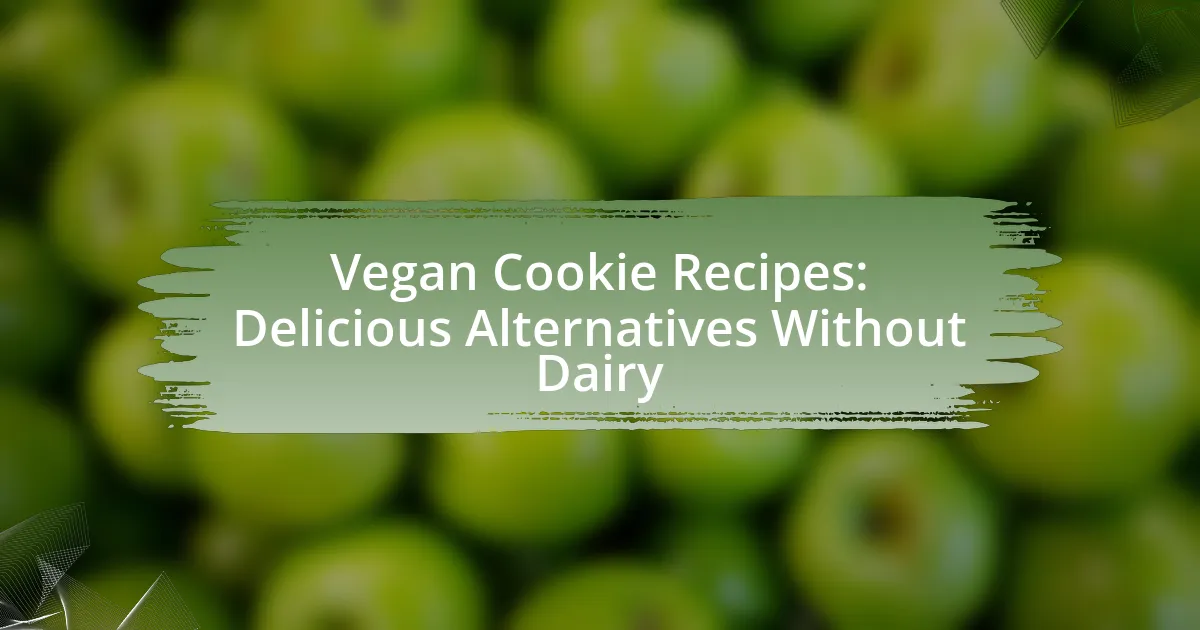The article focuses on the science behind achieving the perfect cookie texture, specifically comparing chewy and crispy cookies. It examines the influence of various factors such as ingredient types, ratios, baking time, and temperature on cookie texture. Key discussions include the roles of flour types, sugar varieties, fat content, and moisture levels in determining chewiness or crispiness. Additionally, the article outlines best practices for baking cookies, common mistakes to avoid, and how to adjust recipes to achieve desired textures, providing a comprehensive understanding of the principles that govern cookie baking.

What Factors Influence Cookie Texture?
The texture of cookies is primarily influenced by ingredients, baking time, and temperature. Ingredients such as flour type, sugar, and fat content play crucial roles; for instance, using bread flour results in a chewier texture due to higher protein content, while all-purpose flour yields a more tender cookie. The ratio of brown sugar to white sugar also affects moisture retention, with brown sugar contributing to a softer, chewier texture. Baking time and temperature are critical as well; cookies baked at a lower temperature for a longer time tend to be softer, while higher temperatures create a crispier exterior. These factors are supported by research indicating that variations in ingredient composition and baking conditions directly correlate with the final texture of baked goods.
How do ingredients affect cookie texture?
Ingredients significantly influence cookie texture by altering moisture content, fat composition, and sugar types. For instance, the use of all-purpose flour versus cake flour affects gluten development; all-purpose flour creates a chewier texture due to higher protein content, while cake flour yields a softer, more tender cookie. Additionally, the ratio of butter to sugar impacts spread and moisture; more butter results in a richer, softer cookie, while less butter can lead to a denser texture. The type of sugar also plays a role; brown sugar adds moisture and chewiness due to its molasses content, whereas granulated sugar contributes to a crisper texture. These ingredient interactions are essential for achieving the desired cookie characteristics, as supported by baking science principles.
What role does flour type play in cookie texture?
Flour type significantly influences cookie texture by affecting gluten development and moisture absorption. All-purpose flour, which has a moderate protein content, typically yields a balanced cookie with a chewy texture, while bread flour, with higher protein, promotes more gluten formation, resulting in a denser and chewier cookie. Conversely, cake flour, which has lower protein, leads to a softer and more tender cookie due to less gluten development. This relationship between flour type and cookie texture is supported by baking science, which indicates that the protein content in flour directly correlates with the structure and chewiness of baked goods.
How do sugars impact chewiness and crispiness?
Sugars significantly influence the chewiness and crispiness of baked goods. When sugars are incorporated into cookie dough, they attract moisture and create a softer texture, contributing to chewiness. This is due to the hygroscopic nature of sugars, which helps retain moisture during baking. Conversely, when sugars caramelize at high temperatures, they contribute to a crispier texture by forming a brittle structure. The balance between different types of sugars, such as granulated sugar and brown sugar, also affects the final texture; for instance, brown sugar contains more moisture and leads to a chewier cookie, while granulated sugar promotes crispiness.
What is the effect of fat content on cookie texture?
Fat content significantly affects cookie texture, influencing whether cookies are chewy or crispy. Higher fat content, such as from butter or oil, typically results in a softer, chewier texture due to the fat coating flour proteins, which inhibits gluten formation. Conversely, lower fat content leads to a firmer, crisper cookie as gluten develops more fully. Research indicates that cookies made with butter have a softer texture compared to those made with shortening, which can create a more crumbly texture due to its higher melting point and lower moisture content.
How does baking time and temperature affect cookie texture?
Baking time and temperature significantly influence cookie texture by determining moisture content and sugar caramelization. Higher temperatures and shorter baking times typically yield cookies that are crispy on the edges and chewy in the center, as the rapid heat causes the outer layer to set quickly while the interior remains soft. Conversely, lower temperatures and longer baking times result in a more uniform texture, often leading to a drier, crisper cookie due to prolonged moisture evaporation. Research indicates that cookies baked at 350°F for 10-12 minutes achieve an optimal balance of chewiness and crispness, while those baked at 375°F for 8-10 minutes tend to be crispier.
What is the ideal baking temperature for chewy cookies?
The ideal baking temperature for chewy cookies is 350°F (175°C). Baking at this temperature allows the cookies to spread properly while maintaining a soft and chewy interior. Research indicates that this temperature promotes even cooking, ensuring that the edges set while the center remains moist, which is essential for achieving the desired chewy texture.
How does overbaking lead to crispy cookies?
Overbaking leads to crispy cookies by allowing excess moisture to evaporate, resulting in a drier texture. When cookies are baked longer than necessary, the heat causes the sugars and fats to undergo further caramelization and browning, which contributes to a firmer structure. This process is supported by the Maillard reaction, where amino acids and reducing sugars react under heat, enhancing flavor and texture. Consequently, the combination of moisture loss and increased caramelization creates a cookie that is crisp rather than chewy.

What are the Characteristics of Chewy Cookies?
Chewy cookies are characterized by their soft, moist texture and a slightly elastic bite. This texture results from a higher moisture content, often achieved through the use of brown sugar, which retains moisture better than white sugar. Additionally, chewy cookies typically contain more fat, such as butter or oil, which contributes to their tenderness. The use of bread flour instead of all-purpose flour can also enhance chewiness due to its higher protein content, which develops more gluten. These factors collectively create a cookie that is dense and chewy rather than crisp or crumbly.
What ingredients contribute to a chewy texture?
Ingredients that contribute to a chewy texture include high-protein flour, brown sugar, and eggs. High-protein flour, such as bread flour, creates more gluten, which enhances chewiness. Brown sugar contains more moisture than white sugar, leading to a denser, chewier cookie. Eggs provide structure and moisture, further contributing to the chewy consistency. These ingredients work together to create the desired chewy texture in cookies, as supported by baking science principles.
How does moisture content influence chewiness?
Moisture content significantly influences chewiness by affecting the texture and structure of baked goods. Higher moisture levels in cookies lead to a softer, more pliable texture, which enhances chewiness, while lower moisture results in a drier, crumblier texture that reduces chewiness. This relationship is supported by the fact that moisture interacts with starches and proteins during baking, creating a more elastic structure that retains chewiness.
What techniques enhance the chewiness of cookies?
To enhance the chewiness of cookies, techniques such as using higher moisture content, incorporating brown sugar, and chilling the dough are effective. Higher moisture content, achieved by adding ingredients like eggs or milk, contributes to a softer texture. Brown sugar contains more moisture than white sugar, which helps retain moisture during baking, resulting in a chewier cookie. Chilling the dough allows the fats to solidify, leading to a denser cookie that maintains chewiness after baking. These methods are supported by baking science, which indicates that moisture retention and fat solidification are crucial for achieving the desired chewy texture.
Why do some people prefer chewy cookies over crispy ones?
Some people prefer chewy cookies over crispy ones due to their texture, which provides a more satisfying mouthfeel and a sense of freshness. Chewy cookies often retain moisture better than crispy cookies, resulting in a softer, denser bite that many find more enjoyable. Research indicates that the balance of ingredients, such as the ratio of brown sugar to white sugar, influences moisture retention and chewiness. For example, cookies made with more brown sugar tend to be chewier because brown sugar contains more moisture than white sugar. This preference for chewiness is also supported by sensory studies showing that texture significantly impacts overall enjoyment of baked goods.
What sensory experiences are associated with chewy cookies?
Chewy cookies are primarily associated with a combination of tactile, gustatory, and olfactory sensory experiences. The tactile experience involves a soft, pliable texture that yields easily to pressure, creating a satisfying mouthfeel. The gustatory experience is characterized by a balance of sweetness and rich flavors, often enhanced by ingredients like brown sugar and butter, which contribute to a deeper taste profile. The olfactory experience includes the warm, inviting aroma of baked dough, often enriched with chocolate or spices, which stimulates appetite and enhances enjoyment. These sensory attributes are supported by the Maillard reaction during baking, which develops complex flavors and aromas, making chewy cookies particularly appealing.
How does chewiness affect the overall enjoyment of cookies?
Chewiness significantly enhances the overall enjoyment of cookies by providing a satisfying texture that engages the senses. This texture allows for a prolonged flavor release, making each bite more enjoyable. Research indicates that consumers often prefer chewy cookies due to their ability to create a balance between softness and resistance, which contributes to a more pleasurable eating experience. A study published in the Journal of Sensory Studies found that participants rated chewy cookies higher in overall satisfaction compared to their crispy counterparts, highlighting the importance of chewiness in cookie enjoyment.

What Defines Crispy Cookies?
Crispy cookies are defined by their dry, crunchy texture, which results from a higher ratio of sugar and fat to flour, along with a longer baking time. This combination allows moisture to evaporate, creating a firm structure. The Maillard reaction, which occurs during baking, contributes to the golden-brown color and enhances flavor, further distinguishing crispy cookies from their chewy counterparts.
What ingredients are essential for achieving a crispy texture?
To achieve a crispy texture in cookies, essential ingredients include granulated sugar, butter, and a higher ratio of flour to fat. Granulated sugar contributes to crispness by promoting caramelization during baking, while butter adds flavor and aids in the spread of the cookie, resulting in a thinner, crisper final product. Additionally, using a higher flour-to-fat ratio helps create a drier dough, which is crucial for achieving that desired crispy texture.
How does the ratio of butter to flour affect crispiness?
The ratio of butter to flour significantly affects the crispiness of baked goods. A higher butter-to-flour ratio typically results in a crispier texture because the fat in butter creates a tender crumb and promotes browning through the Maillard reaction. Conversely, a lower ratio leads to a denser, chewier texture as there is less fat to inhibit gluten formation. Research indicates that cookies with a butter-to-flour ratio of 1:2 tend to be crispier compared to those with a 1:1 ratio, which are often softer and chewier.
What baking techniques can enhance cookie crispiness?
To enhance cookie crispiness, bakers can utilize techniques such as using a higher ratio of granulated sugar to brown sugar, incorporating more fat, and baking at a lower temperature for a longer duration. A higher granulated sugar content promotes crispiness due to its ability to create a drier texture, while more fat contributes to a tender crumb that can still maintain a crisp exterior. Baking at a lower temperature allows for even cooking and moisture evaporation, resulting in a crispier cookie. These methods are supported by the understanding that sugar caramelization and moisture control are key factors in achieving the desired texture in baked goods.
Why might someone choose crispy cookies instead of chewy ones?
Someone might choose crispy cookies instead of chewy ones due to their preference for texture and flavor. Crispy cookies often provide a satisfying crunch that some individuals find more enjoyable than the softer, denser texture of chewy cookies. Additionally, the Maillard reaction, which occurs during baking, enhances the flavor profile of crispy cookies, giving them a richer taste. This reaction is responsible for the browning and complex flavors that develop in cookies baked until crispy, making them appealing to those who appreciate a more pronounced flavor contrast.
What are the flavor profiles typically associated with crispy cookies?
Crispy cookies are typically associated with flavor profiles that include buttery, caramelized, and slightly nutty notes. The buttery flavor arises from the use of butter or margarine, which contributes to the rich taste and enhances the overall sweetness. Caramelization occurs during baking, creating complex flavors that add depth. Additionally, the Maillard reaction, which happens when sugars and proteins react under heat, imparts a nutty flavor, particularly in cookies that contain brown sugar or chocolate. These flavor profiles are essential in defining the sensory experience of crispy cookies, making them distinct from their chewy counterparts.
How does texture influence the perception of freshness in cookies?
Texture significantly influences the perception of freshness in cookies, as consumers often associate a soft, chewy texture with newly baked goods. Research indicates that a chewy texture is perceived as fresher because it suggests moisture retention, while a hard or overly crispy texture can imply staleness. A study published in the Journal of Sensory Studies found that participants rated cookies with a chewy texture higher in freshness compared to those that were crispy or hard, reinforcing the idea that texture plays a crucial role in freshness perception.
What are the best practices for achieving the perfect cookie texture?
To achieve the perfect cookie texture, it is essential to balance ingredients, control baking time, and adjust temperature. Using a combination of all-purpose flour and bread flour can enhance chewiness due to the higher protein content in bread flour, which develops gluten. Additionally, incorporating brown sugar increases moisture and chewiness, while granulated sugar contributes to crispiness.
Baking cookies at a lower temperature, around 325°F, allows for a more even bake, resulting in a softer center and a crisp edge. Monitoring baking time is crucial; underbaking slightly can yield a chewy texture, while overbaking leads to a crispier result.
These practices are supported by baking science, which indicates that the Maillard reaction, responsible for browning, occurs optimally at specific temperatures, influencing both flavor and texture.
How can you adjust recipes to achieve your desired cookie texture?
To achieve your desired cookie texture, adjust the ratios of ingredients and baking times. For chewier cookies, increase the brown sugar relative to white sugar, add an extra egg yolk, and reduce the baking time slightly. Conversely, for crispier cookies, use more white sugar, decrease the fat content, and extend the baking time. These adjustments affect moisture content and spread, which directly influence texture. For instance, brown sugar retains moisture due to its molasses content, resulting in a chewier texture, while white sugar promotes crispness through greater spread during baking.
What common mistakes should be avoided when baking cookies?
Common mistakes to avoid when baking cookies include not measuring ingredients accurately, which can lead to incorrect ratios affecting texture. Overmixing the dough can also result in tough cookies due to gluten development. Additionally, failing to preheat the oven can cause uneven baking, while using cold butter instead of softened butter can prevent proper creaming, impacting the final texture. Lastly, not allowing cookies to cool on the baking sheet can lead to overbaking, as residual heat continues to cook them. These practices are essential for achieving the desired chewy or crispy cookie texture.




